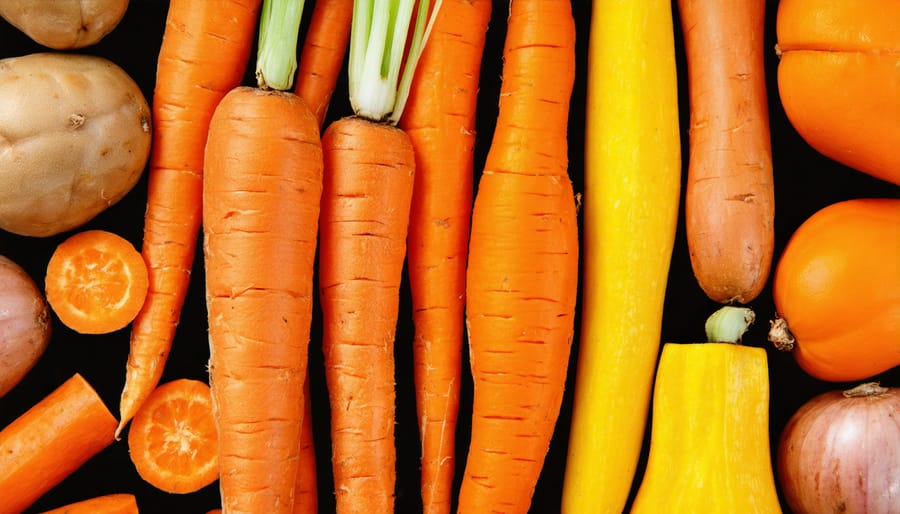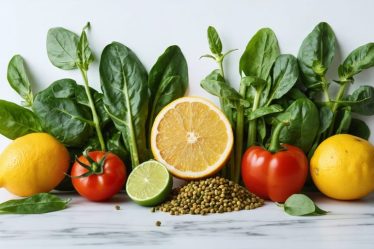
Unlock the vibrant world of beta-carotene, nature’s golden ticket to radiant health and glowing skin. This powerful plant compound, found abundantly in colorful fruits and vegetables, transforms into vitamin A in our bodies through a fascinating biological dance. Whether you’re a wellness enthusiast or simply curious about optimizing your nutrition, understanding this essential nutrient precursor can revolutionize your approach to healthy eating.
Picture biting into a sweet, orange carrot or spooning up creamy butternut squash soup – you’re not just enjoying delicious flavors, you’re nourishing your body with beta-carotene, the most important provitamin A carotenoid. Unlike synthetic supplements, these natural sources provide a safe, regulated way for your body to produce exactly the amount of vitamin A it needs.
Ready to explore how this remarkable compound supports everything from your immune system to your vision, and discover the most delicious ways to incorporate it into your daily meals? Let’s dive into the colorful world of nature’s vitamin A powerhouse.
Beta-Carotene: Your Body’s Natural Vitamin A Factory
How Your Body Transforms Beta-Carotene
Ever wondered how those vibrant orange carrots and leafy greens actually become the vitamin A your body needs? Let me break it down in a way that’s fascinating yet simple to understand. When you eat foods rich in beta-carotene, your body springs into action like a well-orchestrated dance.
First, your digestive system breaks down the food, releasing the beta-carotene. Then, it’s absorbed through your intestinal wall along with a bit of healthy fat (which is why drizzling some olive oil on your salad is such a smart move!). From there, it travels to your liver, where the real magic happens.
Your liver contains special enzymes that split each beta-carotene molecule in half, transforming it into active vitamin A. What’s really clever about this process is that your body is smart enough to convert only what it needs – it’s like having a built-in safety mechanism! Any extra beta-carotene that isn’t converted gets stored in your body’s tissues, which is why you might notice a slight orange tint to your skin if you’ve been enjoying lots of carrots lately.

Why Choose Plant-Based Sources?
When it comes to getting your vitamin A, nature really knows best! I’ve discovered through my own wellness journey that choosing plant-based sources over supplements offers some amazing benefits. Not only does your body regulate the conversion of beta-carotene to vitamin A based on what it needs (pretty smart, right?), but you’re also getting a wonderful bundle of other nutrients along the way.
Think of it as nature’s perfect package deal – when you eat a sweet potato or some leafy greens, you’re not just getting beta-carotene. You’re also receiving fiber, antioxidants, and other vitamins that work together in harmony. This aligns perfectly with personalized nutrition benefits that many of us are seeking.
Plus, it’s practically impossible to overdose on vitamin A from plant sources, unlike with supplements. Your body is brilliant at managing beta-carotene conversion, only transforming what it needs and storing the rest safely. This natural approach also tends to be gentler on your digestive system and more budget-friendly than purchasing supplements. It’s like getting a beautiful bonus of flavors, colors, and textures while nourishing your body!
Colorful Kitchen Heroes: Top Beta-Carotene Rich Foods
Orange and Yellow Powerhouses
Let me share a little secret from my garden: those vibrant orange and yellow vegetables aren’t just pretty to look at – they’re absolute powerhouses of beta-carotene, the plant form of vitamin A that our bodies love! Carrots are probably the first thing that comes to mind, and for good reason. Just one medium carrot provides more than 100% of your daily vitamin A needs. Pretty amazing, right?
Sweet potatoes are another fantastic source, and they’re incredibly versatile in the kitchen. I love roasting them with a drizzle of olive oil and a pinch of cinnamon, which brings out their natural sweetness while packing in those nutrients. And don’t forget about butternut squash – it’s perfect in everything from creamy soups to roasted veggie medleys.
The best part? These vegetables are easy to find year-round and store well, making them perfect pantry staples. Try grating carrots into your morning smoothie, swapping regular fries for sweet potato wedges, or adding cubed butternut squash to your favorite fall stew. Your body will thank you for all that beautiful beta-carotene goodness!

Green Goodness
Let’s talk about nature’s vibrant vitamin A powerhouses – those gorgeous leafy greens! Every time I open my crisper drawer and see a bunch of fresh spinach or kale, I can’t help but smile knowing I’m about to fuel my body with beta-carotene goodness. These green superstars are absolutely packed with this plant-based precursor to vitamin A.
Dark leafy greens like collards, Swiss chard, and romaine lettuce are particularly rich sources of beta-carotene. What I love most about these greens is how versatile they are – toss them in a morning smoothie, craft a beautiful salad, or sauté them as a quick dinner side dish. My personal favorite is adding a handful of baby spinach to my morning eggs – it’s such an easy way to boost my vitamin A intake before the day even begins!
While all leafy greens offer benefits, the darker the leaf, the higher the beta-carotene content. Think of it as nature’s color-coding system! And here’s a pro tip I learned from my nutritionist: pairing these greens with a small amount of healthy fat helps your body absorb the beta-carotene more effectively. A drizzle of olive oil or a few avocado slices does the trick perfectly!

Beauty Benefits of Beta-Carotene
Have you ever noticed how some people seem to have that natural, healthy glow? Well, beta-carotene might be their secret weapon! As someone who’s always been fascinated by natural beauty solutions, I’ve discovered that this powerful plant compound does so much more than just convert to vitamin A in our bodies.
When it comes to skin health, beta-carotene is like nature’s Instagram filter. It works from within to give your skin a subtle, sun-kissed glow by depositing its natural pigments in your skin. But don’t worry – unlike self-tanners, this warm hue looks completely natural and develops gradually over time.
Beyond the beauty boost, beta-carotene acts as a protective shield for your skin. It helps fight those pesky free radicals that can cause premature aging and works alongside your body’s natural defense system to protect against sun damage (though you should still wear your sunscreen!). I’ve noticed that since increasing my intake of beta-carotene-rich foods, my skin appears more resilient and maintains its moisture better.
What I love most about beta-carotene is how it supports skin cell turnover and regeneration. This means fresher, younger-looking skin naturally emerging as older cells are replaced. It also helps in maintaining the skin’s elasticity and smoothness, which is especially important as we age.
For the best results, I’ve found that combining beta-carotene-rich foods with a consistent skincare routine really makes a difference. Think sweet potatoes in your lunch salad or a handful of carrots as your afternoon snack – simple additions that can lead to noticeable improvements in your skin’s appearance over time.
Remember, beautiful skin starts from within, and beta-carotene is one of those gifts from nature that helps us achieve that coveted healthy glow, naturally.
Simple Ways to Add More Beta-Carotene to Your Diet
Adding more beta-carotene to your diet doesn’t have to be complicated! As someone who once struggled with incorporating nutritious foods into my daily routine, I’ve discovered some delightfully simple ways to boost my intake of this important vitamin A precursor.
Start your day with a vibrant smoothie packed with carrots, mangoes, and sweet potatoes. I love throwing in a handful of spinach for an extra nutrient boost – trust me, you won’t even taste it! For lunch, try swapping your regular salad greens for darker alternatives like kale or romaine lettuce. These simple changes can help transform your meals into beta-carotene powerhouses.
Some of my favorite beta-carotene rich snacks include dried apricots, cantaloupe slices, and roasted butternut squash cubes seasoned with a touch of cinnamon. For dinner, try roasting colorful bell peppers and carrots with olive oil and herbs, or whip up a warming sweet potato soup – perfect for those cozy evenings!
Here’s a quick tip from my kitchen: grate carrots into your morning oatmeal or add pumpkin puree to your pancake batter. These small changes not only boost nutrition but also add natural sweetness and beautiful color to your dishes. Remember, the deeper the orange or green color of your fruits and vegetables, the more beta-carotene they typically contain!
As we’ve discovered, beta-carotene is nature’s incredible gift for our health and beauty. From vibrant carrots to leafy spinach, these plant-powered sources of pre-vitamin A are not just nutritious but also delicious. I’ve personally noticed a wonderful glow in my skin since making these colorful foods a regular part of my meals, and I know many of you will too!
Remember, incorporating beta-carotene-rich foods into your diet doesn’t have to be complicated. Try adding some sweet potato to your lunch bowl, snacking on dried apricots, or blending some mango into your morning smoothie. Your body will thank you with improved vision, stronger immunity, and that radiant complexion we all love.
Let’s make it a point to fill our plates with these beautiful, nutrient-rich foods. After all, good health starts with what we put on our fork!



